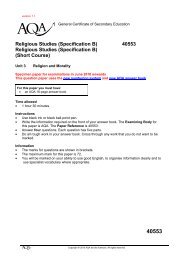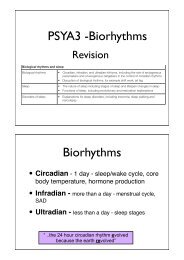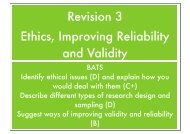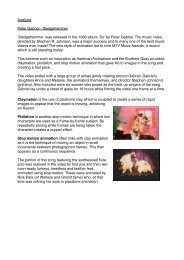stress less 2 stress response - The Grange School Blogs
stress less 2 stress response - The Grange School Blogs
stress less 2 stress response - The Grange School Blogs
- No tags were found...
Create successful ePaper yourself
Turn your PDF publications into a flip-book with our unique Google optimized e-Paper software.
<strong>The</strong> Stress ResponseBATS -All must be able to order the features ofthe sympathomedullary pathway (SAM)and pituitary-adrenal system (HPA) (E)Most should be able to describe theeffects of SAM and HPA on the body (D)Some could explain how SAM preparesthe body for fight or flight and relate to theevolutionary approach (C)
What is <strong>stress</strong>?• Stress is the <strong>response</strong> to a threatwe feel we cannot cope with.What are <strong>stress</strong>ors?Internal or external factors that arethreatening and have the potential tocause a <strong>stress</strong> <strong>response</strong> e.g heat, trafficjam, exams, phobia, illness, accidents
Stress Questionnaire• Now we have considered what <strong>stress</strong>is…..• I would like you to think about yourbehaviour in the last few months and fillout the questionnaire.• We will then work out your scores.
FemaleMaleMean Score Mean ScoreAre there individual differences? Were more males more or <strong>less</strong> <strong>stress</strong>ed thanfemales?
Evaluation of questionnaire• Is this a valid way of measuring <strong>stress</strong>?• What are the flaws?• Subjective – open to interpretation• Time dependent• Requires honesty• Not actually measuring <strong>stress</strong> / <strong>stress</strong> <strong>response</strong>• What could be an alternative methods?
What causes you <strong>stress</strong>?
How does <strong>stress</strong> makeyou feel?Discuss all the feelings you getwhen you are feeling <strong>stress</strong>edYou have these feelingsbecause the body is respondingto the <strong>stress</strong>ful situation andpreparing for you to cope.
GAS – <strong>The</strong>ory of <strong>stress</strong> <strong>response</strong>1930’S Hans SelyeExperimenting on rats – observed that the ratsshowed distinctive physiological changes due todaily injections and other noxious agents (over afew months).Changes included development of stomach ulcers(a <strong>stress</strong> symptom)Selye reported the injections were harm<strong>less</strong> – thusthe process was causing <strong>stress</strong>.
Conclusion: physiological reaction was due to theunpleasant stimulus(<strong>stress</strong>or) and was causinga <strong>stress</strong> <strong>response</strong>.Changes, e.g. stomach ulcer, due to prolonged<strong>stress</strong>or in a situation of low control – does thisoccur in our society?This is where <strong>stress</strong> is problematic and can lead tosimilar and worse physiological changes
How do werespond to<strong>stress</strong>fulsituations?
Physiological Stress ResponseSudden and severe <strong>stress</strong> generally produces:Increase in heart rateAlterations in digestive activitySkin becomes paleSweating increasesMuscular tremors<strong>The</strong>se <strong>response</strong>s are produced by thesympathomedullary pathway (SAM) andhypothalamic pituitary axis (HPA) also know asthe pituitary - adrenal system (PAS)www.psychlotron.org.uk
Physiological Stress ResponseHypothalamusPituitary glandSympatheticganglia<strong>The</strong> <strong>stress</strong> <strong>response</strong>occurs when we areexposed to some sort ofthreat.It involves co-ordinated<strong>response</strong>s from anumber of differentsystems and structureswww.psychlotron.org.ukAdrenal cortexAdrenal MedullaFinish
HypothalamusPituitary glandSympatheticgangliaAdrenal cortexAdrenal Medulla<strong>The</strong> Hypothalamus<strong>The</strong> hypothalamus is incharge of the <strong>stress</strong><strong>response</strong>.When a <strong>stress</strong> <strong>response</strong>is triggered, it sendssignals to two otherstructures: the pituitarygland, and thesympathetic ganglia.www.psychlotron.org.ukFinish
HypothalamusPituitary glandSympatheticganglia<strong>The</strong> Pituitary Gland<strong>The</strong> pituitary glandcontrols the glands ofthe endocrine system.When activated by thehypothalamus itreleases ACTH, whichactivates the adrenalcortex.www.psychlotron.org.ukAdrenal cortexAdrenal MedullaFinish
HypothalamusPituitary glandSympatheticgangliaAdrenal cortexAdrenal Medulla<strong>The</strong> Sympathetic Ganglia<strong>The</strong> sympathetic gangliaare connected to theinternal organs. Whenactivated they affect thefunctioning of the lungs,heart and digestivesystem.<strong>The</strong>y are also connectedto the adrenal medullawww.psychlotron.org.ukFinish
HypothalamusPituitary glandSympatheticganglia<strong>The</strong> Adrenal Cortex<strong>The</strong> adrenal cortexreleases chemicalscalled corticosteriods.<strong>The</strong>se have a number offunctions includingreleasing stored glucoseand controlling swellingafter injury.www.psychlotron.org.ukAdrenal cortexAdrenal MedullaFinish
HypothalamusPituitary glandSympatheticganglia<strong>The</strong> Adrenal Medulla<strong>The</strong> adrenal medullareleases adrenaline.This hormone stimulatesthe sympathetic ganglia,keeping their activity at ahigh level.www.psychlotron.org.ukAdrenal cortexAdrenal MedullaFinish
Fight or Flight ResponseIncreaseoxygen intakeRelease storedglucoseDivert resourcesaway fromdigestionwww.psychlotron.org.ukReady to expend energy,either by fighting or by running away
<strong>The</strong> Fight or Flight ResponseAn early evolutionary adaptation that isuseful in dealing with physical threatsHelps us deal with short-term problemsthat can be solved by fighting or runningUnfortunately, many of the threats we facein our society do not fall into thesecategories…www.psychlotron.org.uk
<strong>The</strong> Autonomic Nervous System<strong>The</strong> position of theHypothalamus
HPA axis(chronic)SAM (acute)
<strong>stress</strong>orhypothalamusPituitary glandAdrenal cortexcortisolHPA axisSympatheticbranch of ANSAdrenal medullaAdrenaline andnoradrenalineSAM
Over to you …Create a role play or poster to show thebiological <strong>response</strong> to <strong>stress</strong>
PlenaryComplete the worksheet on the <strong>stress</strong> <strong>response</strong>Homework – Stress <strong>response</strong> worksheetor Summarise the biological <strong>response</strong> to<strong>stress</strong> (HPA and SMP) in 100 words each• Use diagrams/flow charts to illustrate this.• <strong>The</strong> best way to learn this tricky topic is toteach someone else!!!
















